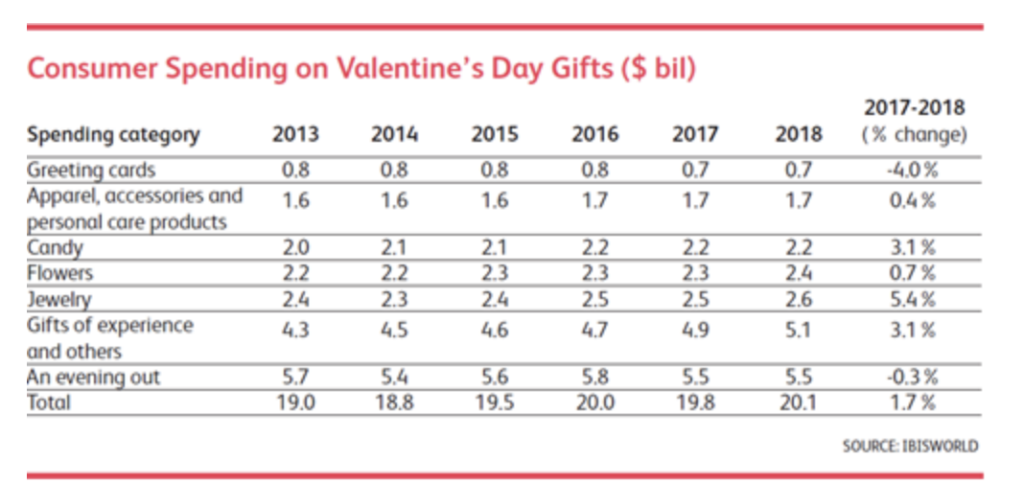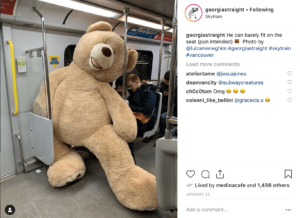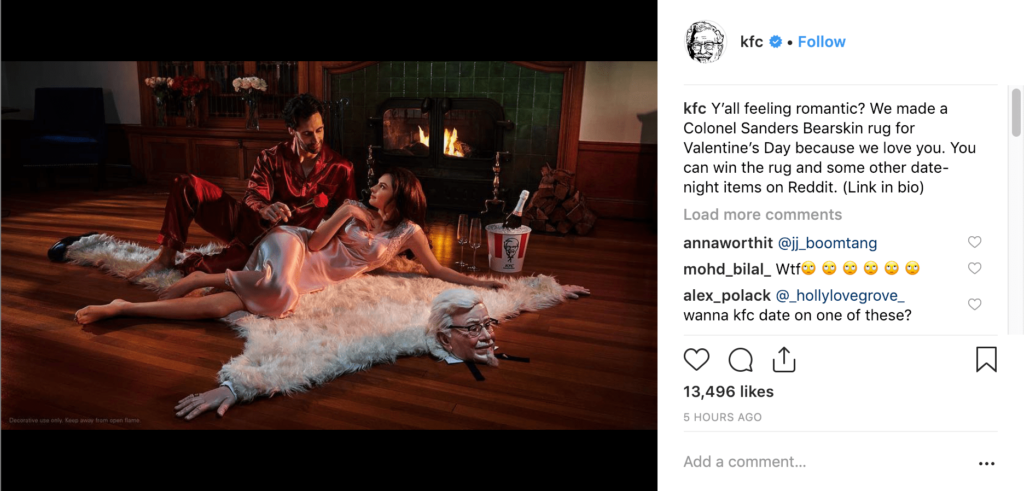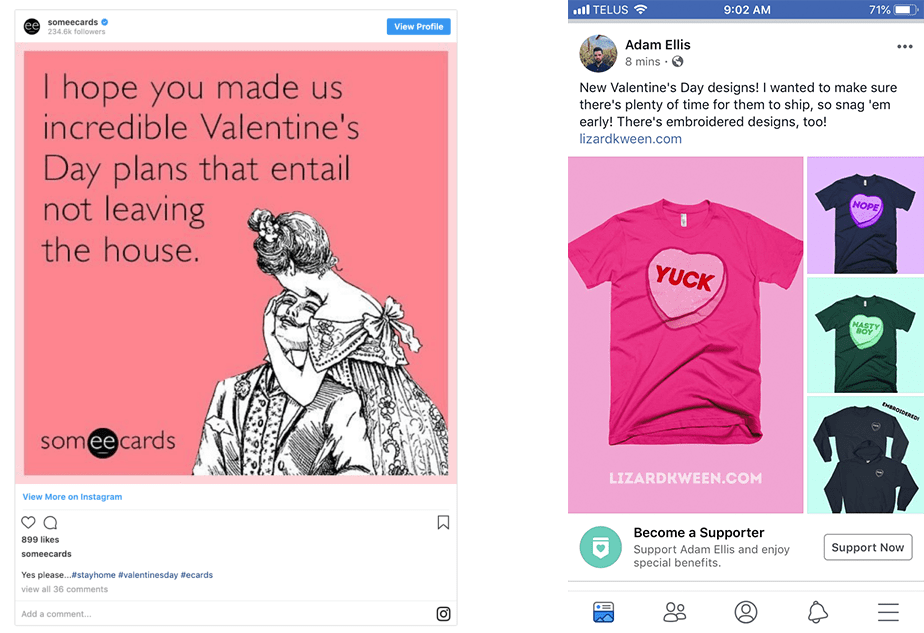Whether you’re a fan of Valentine’s Day or not, it’s difficult to ignore the aisles of pink and red that pop up across stores mid-January. They’re often filled with heart-shaped candy and stuffed animals but, while the brands and characters change, it all feels very…traditional. Notably so, considering how the concept and expression of romance and love have evolved since the holiday became customary in the 1400s. Yet a broader look at marketing trends reveals that even Cupid isn’t completely immune to the zeitgeist.
Interested in the history behind Valentine’s Day marketing? We highly recommend checking out these great articles by Smithsonian Magazine:
Marketing Trend #1: “Let’s Go on an Adventure!”
Most holidays promote gift-giving, but they also encourage a lot of other activities, like

According to a report by IBISWorld, consumer spending on gifts of experience is increasing year-after-year and was up 3.1% in 2018 (Cohen, 2018). Consumers recognize that an experiential present is a chance to strengthen a relationship by spending quality time and sharing interests with a loved one. Businesses and attractions have also taken notice and are hosting more elaborate themed events and in-store activities. For instance, the Vancouver Aquarium’s February After Hours event is all about “what goes down when animals get down.” Much more than a simple Instagram contest or prix fixe meal, the event stars an adult puppet show, educational talks, and plenty of opportunities to see cute sea creatures.
Marketing Trend #2: “Let’s Keep it Low-Key.”
Thanks to expectations built up from countless romantic ads, books, and movies, it’s easy to feel that you need to give your partner a gift that will “take their breath away”, or else you’ve failed some sort of love test. Even if you have a great idea, it can be expensive. Add in constant exposure to curated social media feeds (and trending hashtags like #couplegoals) and it’s enough to send even a die-hard romantic into a panic.

Budget-friendly Dinner Options: Perhaps in response to this tension, budget-friendly dinner options are becoming more commonplace as an acceptable alternative for a Valentine’s Day meal. Research by the National Restaurant Association indicates that Valentine’s Day is the second busiest day of the year, after Mother’s Day, for the restaurant industry (Restaurant Business, 2013). While a formal sit-down restaurant has been the conventional choice, fast food chains, subscription services, and supermarkets have joined in on the profitable celebration:
- Send your special someone a heart-shaped conversation donut from Krispy Kreme.
- Start your Valentine’s Day right with a bowl of limited-edition Reese’s Puffs heart-shaped cereal.
- Surprise your partner to a romantic night out at Waffle House – complete with special menus, tablecloths, and mood lighting.
- Treat yourself to some great holiday grocery savings from online and big-box retailers like Amazon and Target.
- Give the gift of an experience and a meal with special menu options and a discount from Hello Fresh subscription meal service.
- Don’t want to go out, don’t want to cook, but want the comfort of a homecooked dinner? Grab an affordable pre-prepared Valentine’s meal from the Tesco supermarket.

‘Honest’ Valentine’s Day E-Cards: Valentine’s Day is also the second most popular day for sending cards in North America (Husser, 2016). However, demand is decreasing, with revenue falling 4% in 2018, at least partially due to the simplicity of texting a meme or sending an e-card (Cohen, 2018). Naturally, Valentine’s Day messaging, online and in-store, has been influenced by current internet

For an informative recap on the origin of the Valentine’s Day Meme-style E-card, we suggest this entry by Know Your Meme.
Marketing Trend #3: “Let’s Celebrate Platonic Love”
An original intent behind Valentine’s Day was to give us a socially acceptable method to express our feelings. Nowadays, we are much more open about our opinions, often sharing them publicly to strangers on the internet. Instead, our love-related hurdles include dating burnout from endless
Self-Love: Valentine’s Day used to have little to offer a single person aside from the future promise of discounted chocolate. Now companies, and wellness brands, in particular, are targeting people with terms like “Self-Love” and “Treat Yourself”. Advertising copy suggests ways to indulge or engage in relaxing rituals – r
‘Galentine’s Day’: Friends and family have been recipients of Valentine’s Day cards since the beginning of the holiday. However, the term ‘Galentine’s Day’, coined by protagonist Leslie Knope in a 2010 episode of the TV show “Parks and Recreation”, has inspired a real-life push to annually celebrate female friendships (Garber, 2017).
Pets: According to the National Retail Foundation, Americans spent $593 million on their pets for Valentine’s Day in 2017 and were estimated to spend $751 million in 2018 (Mejia, 2018). Quite a jump!

It’s Complicated
At face value, these trends are a move in a positive direction. However, we would be remiss if we didn’t mention that using concepts like self-love become problematic if it’s coming from a company that profits from making people feel bad about themselves. Additionally, while Valentine’s Day products declaring our undying affection for pets, gal pals, and rosé are widely available, finding a greeting card featuring same-sex couples is still a rarity.
Will a day that celebrates something as noble as love ever shake its commercialized reputation? We look forward to seeing how Valentine’s Day, and its marketing, continues to respond to societal shifts. If there are other modern trends you’ve noticed, let us know in the comments or contact us today.
Cohen, A. (2018, February 08). Valentine’s Day Spending to Hit Record-Breaking $20.1 Billion | IBISWorld Industry Insider. Retrieved February 4, 2019, from https://www.ibisworld.com/industry-insider/industry-insights/valentine-s-day-spending-to-hit-record-breaking-201-billion/
Garber, M. (2017, February 13). How Galentine’s Day Went From a Beloved Fiction to a Beloved Tradition. Retrieved February 4, 2019, from https://www.theatlantic.com/entertainment/archive/2017/02/each-day-is-galentines-day/516408/
Goldman, D., Marchessou, S., & Teichner, W. (2017, December). Cashing in on the US experience economy. Retrieved February 4, 2019, from https://www.mckinsey.com/industries/private-equity-and-principal-investors/our-insights/cashing-in-on-the-us-experience-economy
Husser, A. (2016, February 13). Too easy to text? Why the digital age isn’t killing off Valentine’s Day cards | CBC News. Retrieved February 4, 2019, from https://www.cbc.ca/news/canada/greeting-cards-valentine-s-day-trends-1.3440973
Mejia, Z. (2018, February 14). Americans are spending $751 million on their pets for Valentine’s Day. Retrieved February 4, 2019, from https://www.cnbc.com/2018/02/14/americans-are-spending-751-million-on-their-pets-for-valentines-day.html
Restaurant Business. (2013, February 8). Valentine’s Day: The second-busiest day of the year. Retrieved February 4, 2019, from https://www.restaurantbusinessonline.com/consumer-trends/valentines-day-second-busiest-day-year

